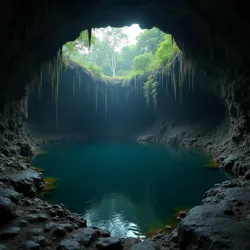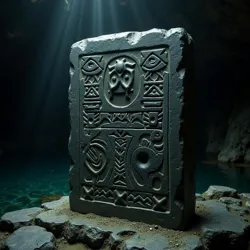Black Cenote District
 The infamous Cenote Negro, the largest sinkhole in the district, known for its extreme temporal distortion effects
The infamous Cenote Negro, the largest sinkhole in the district, known for its extreme temporal distortion effectsThe Black Cenote District is a network of interconnected limestone sinkholes located in the eastern region of the Yucatan hinterlands. Notable for its extreme temporal anomalies and geological peculiarities, the district forms one of the most thoroughly documented Yucatan Anomalous Zones. The area encompasses approximately 40 square kilometers of karst terrain containing over 200 documented cenotes, with the majority exhibiting unexplained phenomena ranging from time dilation to gravitational inconsistencies.
Geological Features
The district's limestone bedrock dates to the late Cretaceous period, though recent studies suggest portions of the rock exhibit impossible dating patterns, with some samples appearing to be both older and younger than surrounding strata simultaneously. The cenotes themselves range in diameter from 2 to 60 meters, with depths varying between 10 and 150 meters. The largest and most notorious of these formations is the Cenote Negro, whose waters appear to absorb all light that reaches them.
The geological composition of the district defies conventional analysis, with mineral formations that seem to reorganize themselves over time. The Hartmann-Veracruz Expedition documented the first instances of what they termed "lithic flux," where solid rock appears to flow like liquid under certain conditions. This phenomenon becomes particularly pronounced during the seasonal Night of the Wandering Lights, when the boundaries between solid matter and void seem to blur.
Temporal Anomalies
The most significant and well-documented feature of the Black Cenote District is its effect on the passage of time. Visitors frequently report experiencing temporal displacement, with time appearing to move at different rates depending on location and depth within the cenotes. The Temporal Mapping Initiative of 2016 recorded variations ranging from minutes to weeks between synchronized chronometers placed at different points throughout the district.
These temporal distortions appear to follow certain patterns, with the strongest effects occurring in what researchers term "depth nodes" - specific points within cenotes where multiple temporal streams intersect. The phenomenon known as Cenote Time Sickness affects approximately 30% of visitors who spend more than 48 hours in the district, manifesting as severe disorientation, memory disturbances, and in some cases, apparent aging or de-aging.
Indigenous History and Cultural Significance
 A pre-Columbian stone marker bearing temporal warning glyphs, discovered at the entrance to Cenote Negro
A pre-Columbian stone marker bearing temporal warning glyphs, discovered at the entrance to Cenote NegroThe Maqamiztleca considered the Black Cenote District sacred to Hmeyotlotl, believing the sinkholes served as portals through which the deity could manipulate the flow of time. Archaeological evidence suggests the area was used for complex religious ceremonies, particularly during astronomical alignments. The discovery of the Chronolith Tablets in 2019 provided insight into how pre-Columbian peoples may have attempted to harness or mitigate the district's temporal effects.
Local oral traditions speak of the "Time Keepers," a specialized class of priests who could allegedly navigate the district's temporal currents. These individuals were said to undergo years of training in specialized breathing techniques and mental disciplines to maintain their temporal coherence while exploring the deeper cenotes. Modern researchers have noted similarities between these historical accounts and the protective protocols developed by the Anomalous Zone Research Institute.
Research History
Scientific investigation of the Black Cenote District began in earnest following the Hartmann-Veracruz Expedition of 1932. Early research efforts were hampered by equipment failures and the disappearance of several research teams, including the notorious case of Dr. Maria Suarez, whose expedition emerged from Cenote Negro appearing to have aged forty years despite spending only three days within the sinkhole.
The establishment of the Temporal Research Station Alpha in 2010 marked the first successful attempt at maintaining a permanent scientific presence within the district. The station employs a complex system of temporal shielding based on principles derived from both modern physics and traditional Maqamiztlec knowledge. Despite these precautions, research personnel are limited to two-week rotations to prevent cumulative temporal exposure.
Modern Studies and Discoveries
Contemporary research focuses on understanding the mechanism behind the district's temporal anomalies. The Chronometric Analysis Project has identified several patterns in the temporal distortions, suggesting they may be influenced by lunar cycles and geological activity. Of particular interest is the apparent correlation between the strength of temporal effects and the presence of certain mineral deposits unique to the region.
The discovery of temporally displaced artifacts has provided valuable insights into both the district's properties and pre-Columbian history. Items recovered from various cenotes include objects from different historical periods, some of which appear to be from possible future times. The Temporal Artifact Registry maintains a detailed catalog of these findings, though access to this information is strictly controlled by the Tla'tlaqixi Research Initiative.
Conservation and Access
The Black Cenote District is currently protected under the Yucatan Anomaly Protection Act, with access restricted to authorized research personnel and indigenous religious practitioners. The Tla'tlaqixi Conservation Trust maintains a buffer zone around the district to prevent unauthorized entry and monitors the cenotes for signs of environmental degradation.
Efforts to preserve both the physical site and its associated cultural heritage have led to collaboration between scientific institutions and local indigenous communities. The Brotherhood of the Eternal Spore plays a crucial role in these efforts, sharing traditional knowledge about safe navigation of the district while helping to maintain sacred sites within the zone.
See also
- Dimensional Convergence Theory
- Pre-Columbian Anomalous Sites
- Chronometric Phenomena of the Yucatan
References
Research data and historical documentation regarding the Black Cenote District are maintained in the Temporal Research Station Alpha archives, with restricted copies held at the University of Mexico City. Indigenous knowledge and oral histories are preserved through the combined efforts of local communities and the Tla'tlaqixi Conservation Trust's Cultural Heritage Division.